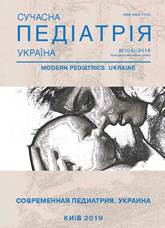Clinical «masks» of somatoform disorders of the cardiorespiratory system and pain and non-specific somatoform disorders in children associated with affective states
Keywords:
somatoform disorder, depression, anxiety, childrenAbstract
The aim of the study is to investigate the features of clinical manifestations of somatoform disorders (SD) by the cardiorespiratory system (CRS) and pain and nonspecific SD (PNSD), as well as their relationship with affective conditions in adolescent children.Materials and methods. 48 children with SD from the CRS and 41 children with SD from the PNSD were examined. The mean age of children was 14.1±4.72 years (M±ρ), of which boys were 52.8% (n=47), girls — 47.2% (n=42). Spielberger test was used to investigate anxiety. The Child Depression Questionnaire M. Kovacs (1992) was used to diagnose depression. The probability was evaluated using the Student's t-test.
Results. SD was most commonly found in boys (58.3%) (p<0.039), mainly in rural areas (62.5%) (p<0.01). Most commonly, SD in boys manifested a transient increase in blood pressure (100%), headache (75%), and palpitations with a predominance of tachycardia (75%), whereas girls had a significantly higher incidence of fatigue (71.4%) and hypotension with syncope. states (57.1%) (p<0.05). Depression was reported in 29.2% of children with SD and 87.5% of children showed clinically expressed anxiety. PNSD was mainly affected by children of early adolescence — 23 (56.1%), who most often showed nonspecific persistent pain syndromes (82.9%) (headache, joint pain, fibromyalgia syndrome, back pain, etc.); disorders (43.9%) and asthenic syndrome (34.2%). In patients with PNSD, 48.8% of children were diagnosed with depression and 95.1% had anxiety.
Conclusions. Depressive disorders as well as anxiety disorders can be one of the key factors for the occurrence of SD in children and manifest themselves in a variety of somatic masks in the form of functional disorders of organs and systems, persistent pain syndromes, complicating the diagnosis and effectiveness of treatment. Anhedonia (64.3% and 65.0%, respectively) was the most frequent manifestation of depression in patients SD with CRS and PNSD. Less often, the key symptom of depression was low mood (7.1% and 5.0%, respectively).
The research was carried out in accordance with the principles of the Helsinki Declaration. The study protocol was approved by the Local Ethics Committee of an institution. The informed consent of the patients was obtained for conducting the studies.
References
Vejn AM. (2003). Vegetativny`e rasstrojstva: klinika, diagnostika, lechenie. Moscow: MIA: 752.
Dermanova IB. (2002). Oprosnik issledovaniya trevozhnosti u starshih podrostkov i yunoshey (C.D. Spilberger, adaptaciya A.D. Andreeva). Diagnostika emocional'no0nravstvennogo razvitiya. Saint Petersburg: 75–80.
Iskakova UB, Abisheva ZS, Zhurunova MS, Zhetpisbayeva GD, Ismagulova TM. (2016). Situationalanxiety and psycho0emotional state of the students during the boundary control. International journal of applied and fundamental research. 11: 900–902.
Maidannyk VH, Mitiuriaieva-Korniiko IO, Kukhta NM, Hnyloskurenko HV. (2017). Vehetatyvni dysfunktsii u ditei. Paroksyzmalna vehetatyvna nedostatnist. Kyiv: Lohos: 300.
Agarwal V, Srivastava C, Sitholey P. (2019). Clinical practice guidelines for the management of somatoform disorders in children and adolescents. Indian J Psychiatry. 61(2): 241–246. https://doi.org/10.4103/psychiatry.IndianJPsychiatry_494_18; PMid:30745699 PMCid:PMC6345131
Chhabria A. (2015). Psychogenic Pain Disorder — Differential Diagnosis and Treatment. J Assoc Physicians India. 63(2): 36–40.
Croicu C, Chwastiak L, Katon W. (2014). Approach to the Patient with Multiple Somatic Symptoms. Med Clin N Am. 98(5): 1079–1095. https://doi.org/10.1016/j.mcna.2014.06.007; PMid:25134874
Hauser W, Henningsen P. (2014). Fibromyalgia syndrome: A somatoform disorder? Eur J Pain. 18(8): 1052–9. https://doi.org/10.1002/j.1532-2149.2014.00453.x; PMid:24453056
Kovacs M. (1992). The Children's Depression Inventory. Toronto. ON: Multi-Health Systems Inc.
Kurlansik SL, MaffeI MS. (2015). Somatic Symptom Disorder. Am Fam Physician. 93(1): 49–54.
Rijavec N, Grubic VN. (2018). Depression and pain: often together but still a clinical challenge — a review. 24;4: 346–352.
Rossi M, Bruno G, Chiusalupi M, Ciaramella A. (2018). Relationship between Pain, Somatisation, and Emotional Awareness in Primary School Children. Pain Res Treat. 12;2018: 4316234. https://doi.org/10.1155/2018/4316234; PMid:30538863 PMCid:PMC6260528
Silber TJ. (2011). Somatization Disorders: Diagnosis, Treatment, and Prognosis. Pediatrics in Review. 32: 56–64. https://doi.org/10.1542/pir.32-2-56; PMid:21285301
Downloads
Issue
Section
License
The policy of the Journal “MODERN PEDIATRICS. UKRAINE” is compatible with the vast majority of funders' of open access and self-archiving policies. The journal provides immediate open access route being convinced that everyone – not only scientists - can benefit from research results, and publishes articles exclusively under open access distribution, with a Creative Commons Attribution-Noncommercial 4.0 international license (СС BY-NC).
Authors transfer the copyright to the Journal “MODERN PEDIATRICS. UKRAINE” when the manuscript is accepted for publication. Authors declare that this manuscript has not been published nor is under simultaneous consideration for publication elsewhere. After publication, the articles become freely available on-line to the public.
Readers have the right to use, distribute, and reproduce articles in any medium, provided the articles and the journal are properly cited.
The use of published materials for commercial purposes is strongly prohibited.

